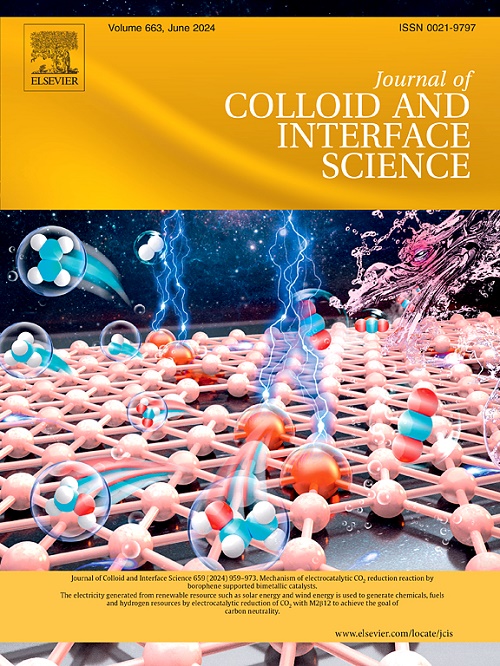Co3S4/MnS p-p heterojunction as a highly efficient electrocatalyst for water splitting and electrochemical oxidation of organic molecules
IF 9.4
1区 化学
Q1 CHEMISTRY, PHYSICAL
引用次数: 0
Abstract
In this work, Co3S4/MnS p-p heterojunction catalyst with hollow structure was successfully synthesized by one-step hydrothermal method. For oxygen evolution reaction (OER), urea oxidation reaction (UOR), lactate oxidation reaction (OER-LA) and glucose oxidation reaction (GOR), 1.59 V, 1.49 V, 1.54 V and 1.40 V vs. RHE are required to drive a current density of 50 mA cm−2, respectively, and the overpotential of hydrogen evolution reaction (HER) in 1 M KOH is 0.193 V at 50 mA cm−2. For the two-electrode overall water splitting in 1 M KOH, 1 M KOH containing 0.5 M urea, 1 M KOH containing 0.125 M lactate electrolyte and 1 M KOH containing 0.3 M glucose, water splitting voltages are only required at 1.73 V, 1.60 V, 1.62 V and 1.63 V to drive the current density of 50 mA cm−2. Moreover, its activity does not attenuate significantly in 1 M KOH containing 0.125 M lactate after continuous operation at 50 mA cm−2 for 200 h, showing excellent durability. In addition, the technology of glucose oxidation assisted water splitting for hydrogen production has been preliminarily explored, which also has excellent HER performance. Density functional theory (DFT) show that the p-p heterojunction between Co3S4 and MnS is conducive to the redistribution of electrons at the interface, thus promoting electron migration. Finally, the water splitting cell coupled with lactic acid oxidation reaction using polylactic acid pipette as source also exhibits high activity and stability. This study provides another idea and strategy for hydrogen production while waste plastic treatment.

Co3S4/MnS p-p异质结作为水分解和有机分子电化学氧化的高效电催化剂
本文采用一步水热法成功合成了Co3S4/MnS p-p异质结空心结构催化剂。对于析氧反应(OER)、尿素氧化反应(UOR)、乳酸氧化反应(OER- la)和葡萄糖氧化反应(GOR),分别需要1.59 V、1.49 V、1.54 V和1.40 V来驱动50 mA cm - 2的电流密度,在1 M KOH中析氢反应(HER)的过电位为0.193 V, 50 mA cm - 2。在1 M KOH、1 M KOH含0.5 M尿素、1 M KOH含0.125 M乳酸电解质和1 M KOH含0.3 M葡萄糖的条件下进行双电极整体水分解,仅需1.73 V、1.60 V、1.62 V和1.63 V的水分解电压即可驱动50 mA cm−2的电流密度。在含0.125 M乳酸的1 M KOH中,在50 mA cm−2条件下连续运行200 h后,其活性没有明显减弱,表现出优异的耐久性。此外,还初步探索了葡萄糖氧化辅助水裂解制氢工艺,该工艺也具有优异的HER性能。密度泛函理论(DFT)表明,Co3S4与MnS之间的p-p异质结有利于电子在界面处的重新分布,从而促进电子的迁移。最后,以聚乳酸移液管为源的水裂解池耦合乳酸氧化反应也表现出较高的活性和稳定性。本研究为废塑料处理产氢提供了另一种思路和策略。
本文章由计算机程序翻译,如有差异,请以英文原文为准。
求助全文
约1分钟内获得全文
求助全文
来源期刊
CiteScore
16.10
自引率
7.10%
发文量
2568
审稿时长
2 months
期刊介绍:
The Journal of Colloid and Interface Science publishes original research findings on the fundamental principles of colloid and interface science, as well as innovative applications in various fields. The criteria for publication include impact, quality, novelty, and originality.
Emphasis:
The journal emphasizes fundamental scientific innovation within the following categories:
A.Colloidal Materials and Nanomaterials
B.Soft Colloidal and Self-Assembly Systems
C.Adsorption, Catalysis, and Electrochemistry
D.Interfacial Processes, Capillarity, and Wetting
E.Biomaterials and Nanomedicine
F.Energy Conversion and Storage, and Environmental Technologies

 求助内容:
求助内容: 应助结果提醒方式:
应助结果提醒方式:


